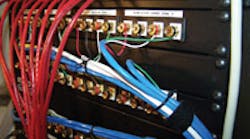As a generation that has little or no memory of a time without PCs and MTV, young adults looking to buy their first home are likely to care more about cable and Internet access than a big backyard. When it comes to distributing audio, video, and data throughout the home, structured cabling (also know as low-voltage wiring) is still recognized as the most reliable method for home networking, period. In response to growing demand, 68% of homebuilders are offering structured cabling in their new homes, according to a 2004 survey of more than 250 builders conducted by Parks Associates, a digital and home networking research firm based in Dallas. And the majority of them expect electrical contractors to install it.
“As builders start to offer additional technology amenities, it's natural for them to look to the [electrical] contractors that they have been working with — and that are already on the jobsite — to do some of the work for them,” says Bill Ablondi, home systems analyst for Parks Associates.
For electrical contractors that choose to participate in the structured cabling market, experts predict big financial gains in the near future. Spurred by the pervasive availability of broadband Internet access, the U.S. structured cabling system market is predicted to grow from $580 million in 2005 to $900 million by 2008, Ablondi says.
Larry Dashiell, whose Santa Rosa, Calif.-based companies, Summit Electric and Summit Electronic Systems, are involved in residential electrical and structured wiring installations, says that electrical contractors can earn 5% to 6% net profit on a structured cabling installation job, as opposed to 2% to 4% on a typical electrical wiring job.
A competitive edge
Many large commercial electrical contractors have been involved in the structured cabling market for years. But for small firms struggling to keep up with the booming housing market while dealing with a major labor shortage, installing structured cabling may feel more like a hassle than a great business opportunity.
Dashiell says that many electrical contractors installing structured cabling in homes today are not prepared and properly trained (see Sidebar at right), mainly because it's not a job opportunity they are purposely pursuing. “They're doing it [installing structured cable] because their builders are telling them they have to, but I definitely don't think they want to,” he says. “Then they realize, ‘Hey, I can make a little money at this,’ and they just kind of throw the wiring in real quick, but they don't ever try to pursue more opportunities in that kind of channel of business.”
Electrical contractors that do install structured cabling without a solid knowledge of the process may be putting both the home's network and their own professional reputation at risk. However, refusing to take part in the structured cabling market may not be the best move for an electrical contractor either.
The vast majority of builders believe structured cabling will soon become standard in new homes. When this happens, electrical contractors with structured cabling installation training may have a strong edge over their competitors bidding for new jobs.
Handle with care
There are some important differences between pulling electrical wires and pulling structured cabling that electrical contractors need to be aware of to provide quality work and earn a good reputation in this growing field. One of the biggest differences between electrical wiring and structured cabling is the fragility of the latter. “In the installation of structured cabling, you can easily destroy the performance of the cables if they're not handled right,” says home and building systems consultant Ken Wacks.
For example, the maximum pulling tension for low-voltage cable is much less than that used for electrical cables. Each manufacturer has its own standard, but less than 25 pounds is typically recommended. What will happen if more force is used? “One improper tug at a wire, and you can pull out the twist that is so carefully put in by the manufacturer, degrading performance,” Wacks says.
It is also important to note that the low-voltage cable, such as fiber optic cable, cannot bend at a 90 angle, so it must form a loop in order to turn in a different direction. The radius of this loop also depends on manufacturer specifications. If there is too sharp of a bend in the cabling, some of the cable fibers could break or kink and also degrade the signal.
There are three major cable types typically bundled together to make up a structured wiring system: Cat. 5e, RG-6, and fiber optic. Cat. 6 is also now available, allowing an even greater data rate than Cat. 5e. These cables are usually installed after all of the electrical wiring is in place. You must install low-voltage cables at least 12 inches away from electrical wires, and run them parallel to one another. They must not be closer than this for more than 6 feet. If electrical wires and low-voltage cables cross, they must do so at a 90° angle.
The entire home's structured cabling runs to and from the low-voltage distribution panel. The distribution panel has cable running to it from demarcation points, where cable television, Internet, and telephone signals enter the home. Each structured cabling bundle starts at the distribution panel and runs directly to its given room and outlet in what is called “star wiring.” Typical set-ups call for one structured cable outlet per bedroom, family room, and kitchen.
Keeping up with the competition
Though many builders seem willing to give their structured cabling work to electrical contractors, some are still not sure they will perform at the level of electronic systems contractors, alarm system installers, and even home entertainment installers — all specifically trained in low-voltage installations.
“I think the electrical contractors have a ways to go to prove that they know what they're doing in this area [structured cabling],” says Frank Murawski, market analyst and president of FTM Consulting, Hummelstown, Pa. “Their background and experience is on the electrical side, which is totally different than on the communications side.”
Still, many homebuilders like Craig Lawson of Santa Rosa, Calif.-based Pinnacle Builders prefer to use one contractor to install both the electrical and structured wiring. Lawson says having that single point of contact is easier for him logistically and saves him about 10% to 20% on the installation cost.
Beyond competition posed by other cable installers, electrical contractors breaking into the structured cabling market will also be competing with other home networking technologies, such as powerline communication (PLC) and wireless systems. Though these systems may not be as reliable as structured cabling yet, they are generally much cheaper and require little or no professional installation. As these other home networking technologies evolve, the number of builders installing structured cable systems may start to decline.
Despite the obvious competitive challenges, most experts believe electrical contractors can go head to head with their cable installer counterparts — the key is saving builders time and money while providing quality work. “There's a business opportunity here,” Wacks says. “But you have to learn how to do it right, or else you're ultimately going to have unhappy customers.”
Training Resources
To learn how to install structured cabling correctly, electrical contractors can look to manufacturers and trade organizations, both of which offer training and certification programs. The following list outlines several good resources.
CompTIA (www.comptia.org)
The Computing Technology Industry Association (CompTIA) certification exam is a cross-industry, vendor-neutral credential. The CompTIA HTI+ certification is based on a set of standards designed to measure the mastery of core competencies regarding the installation, integration, and troubleshooting of the following automated home sub-systems: Home Security, Audio/Video, Computer Networks, Electrical Wiring, HVAC (Heating/Air Conditioning Systems), Cable/Satellite, Broadband, Telecommunications and Structured Wiring.
CEDIA (www.cedia.org/education)
The Custom Electronic Design and Installation Association (CEDIA) offers two levels of professional certification for installers. Level 1 is designed for installers, and Level 2 is designed for supervisors of installers. Certification must be renewed every 36 months. CEDIA also offers a three-day long electronics system electrician residential “boot-camp,” which focuses on the fundamentals of cabling.
Consortium for Electronic Systems Technician Training (www.hightechjobs.org)
The Consortium for Electronic Systems Technician Training was formed in February 1998 to find solutions to the labor shortage. The electronic systems contracting companies then partnered with the National Center for Construction Education and Research to offer education and training for electronic systems technicians. The consortium developed a three-level curriculum used in vocational schools and community colleges across the nation.
After receiving the proper training and/or certification, it is important to stay abreast of any changes made in the U.S. standard for residential structured cabling, TIA-570B, which mandates such things as how many outlets are needed, what kind of cables should be used, and how to properly terminate these cables. The NEC also contains some guidelines about structured cabling, found primarily in chapters six through eight.



